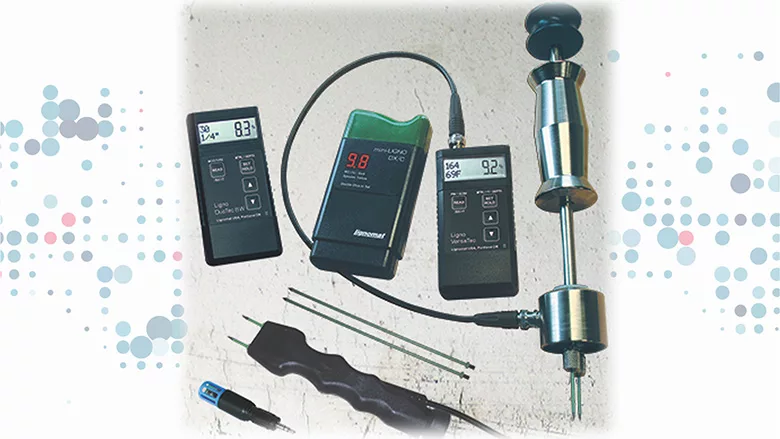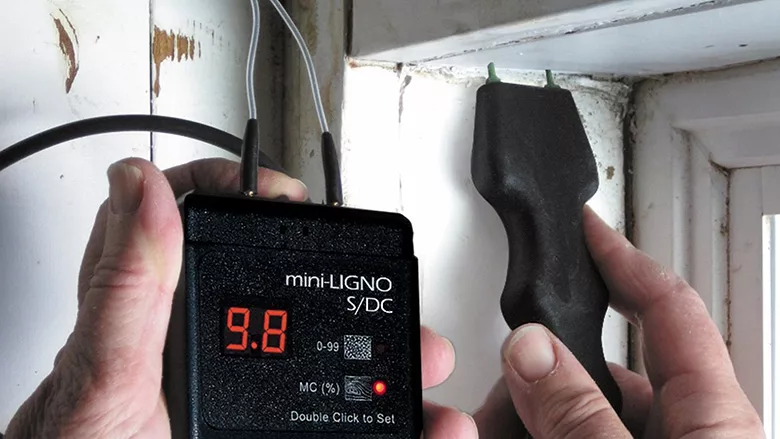Moisture Meters for Assessment of Water Damage

Selection of moisture meters: pin, pinless and combination meters pin - pinless - RH Thermo-Hygrometers
All Photos courtesy of Grete Heimerdinger

This is the mini-Ligno S/DC with calibrations for standard drywall, water-resistant backerboard, exterior and interior glass matte panels. The mold stain on wall is old, and the drywall has dried out, which is indicated by the low moisture percentage indicated by the meter.

Moisture meter with slim Electrode E14 and Teflon-coated pins is used to check moisture levels in a corner of a window frame. Integral pins of meter do not fit into the corner.

Measuring moisture in a shower. The meter has a calibration setting for drywall (#10) and measures only ¼” deep. Wall studs and other structural element behind the sheetrock are not affecting the measurements, when the measuring depth is only ¼” and the thickness of the sheetrock is at least ¼”. A value of 1.3% too high. The panel needs to dry out more or it needs to be removed.




A) Why?
Most building materials are hygroscopic, which means they will absorb or lose moisture depending on the humidity of the surrounding air or the presence of excess water from broken pipes, leaky roofs or worst from floods.
High moisture levels should be avoided, and if they exist, remediation should be done without delay. When too much moisture has been absorbed, building materials will lose their structural integrity and strength. Another hazard of too much moisture is mold growth. It is only a question of time until mold will start to grow, if enough humidity is in the air and enough moisture in the material.
Spores from mold are present almost anywhere at any time. They can be dormant for a long time, just waiting for the right moisture and humidity conditions to start growing. However, mold should be avoided for two reasons:
- Number 1: Mold uses the carbohydrates contained in building materials as food and thus disintegrates the material it is living on.
- Number 2: Mold generates toxic compounds, while digesting its food. Furthermore, one mold colony can grow millions of spores and release them into the surrounding air. The contaminated air is hard on people’s lungs and can cause serious illness. https://www.lignomatusa.com/why-is-mold-so-bad/
For all the reasons mentioned above, remediation after water contamination should be done fast and thoroughly. One of the main tools to use are moisture meters, which can assess the moisture condition of materials before starting remediation work. Meters should also be used to make sure all excess moisture is gone once the work is finished. (Keep in mind that not all building materials can be measured. There are lightweight materials where moisture meters fail to register, and other means have to be used to determine if high moisture levels exist.)
B) What Meter, Pin or Pinless?
Pin meters come with built-in pins and/or with different style hand probes, which can be used with a variety of pins. In order to get good measurements, the pins have to penetrate the material. Moisture is measured in the area between the uninsulated part of the pins. If pins are not insulated, the meter will register the highest moisture content, which could be condensation at the surface.
The advantages are that pins are available in different lengths to measure at the surface and deep inside walls, in corners, in crevices, and other hard-to-reach areas. It is in many cases not enough to measure moisture at the surface. Depth measurements are necessary to find out if moisture has infiltrated into different parts of the structure. For instance, water from a leaky roof can travel into portions of a wall and down several stories.
An additional advantage of a pin meter is that pins can be insulated and measure moisture only at the depth the pins are driven to. With insulated pins, low moisture levels can be found, even behind a wet surface. As the pins are driven into the material, measurements can be obtained at different depth levels, and a moisture gradient can be established. Be aware that when different materials are penetrated, measured values cannot be compared but may need to be corrected for the material measured.
Also available for pin meters are extension cables to monitor moisture over a longer period of time in areas which are hard to reach or closed-up after repair work is finished.
Pinless meters have flat measuring plates or ball probes, which are placed on top of the surface to measure moisture in the material below. The measuring depth is specific for each instrument. Some meters offer two different measuring depths, which can be very helpful in differentiating between moisture close to the surface or deeper down. Pinless meters indicate the average of moisture within the measuring field.

The advantage of pinless meters is that many measurements can be obtained in a short time without penetrating the material. For a restoration job, that means moving a pinless meter across a wide area can show affected versus unaffected areas quickly.
The best option is given when using a combination pin and pinless meter side by side. Pinless measurements give a quick overview of the affected area, and pin measurements allow to precisely determine the depth of the water infiltration.
C) What Measuring Scale?
When measuring moisture in wood, the wood moisture content is indicated in a percent based on the dry weight of the material.
It is understood that accurate measurements are only possible when the meter is set to the correct wood species. That is the same when measuring moisture in building materials other than wood. To obtain accurate percent measurements, a meter needs to be calibrated for the material to be measured. However, it is almost impossible to find one meter with calibrations for all materials used in the building industry today.
The following are three different modes of operation for using a pin or pinless moisture meter to obtain the information needed to accomplish a successful remediation job:
- Percent scales
- WME scales (wood moisture equivalent)
- Relative or comparative scales (example 0-100)
1) Percent scales for wood, sheetrock, wall panels and other building materials are based on the ratio of the weight of the water to the weight of the oven dried material.
The goal of the measurements is to determine the moisture condition at the moment and to find out if the material has dried enough. When using a percent scale, it is necessary to know what value represents the dry condition or at least an acceptable, safe condition. For instance, when measuring the moisture content in wood with a moisture meter, wood is considered dry for wood floors, doors and cabinets at 6-9%, for moldings 12% and for structural lumber 16-19%. It is assumed that every wood moisture meter is calibrated to moisture percentages based on dry weight.
The EMC equilibrium moisture content chart for wood (from the U.S. Dept. of Agriculture “Wood Handbook, Wood as an Engineering Material”) puts these wood moisture content values in a comprehensive relationship with relative humidity of air. The EMC chart shows for every wood moisture percentage the corresponding relative humidity, when wood is stable and does not absorb or lose any moisture. For structural lumber, the moisture content between 16% corresponds with a relative humidity between 80% at 700F.

Using the EMC table:
Examples: To keep wood at a moisture level of 6.2%, a constant relative humidity of 30% and a temperature of 700F is required. If the relative humidity increases above 30%, wood will pick up moisture accordingly.
If the relative humidity would be around 60% for an extended period of time, the wood and other building materials will pick up moisture until 11% has been reached.
When measuring moisture in cementitious materials, concrete, sheetrock, wall panels, etc., the percentage a moisture meter indicates is very small, starting at 0.2% for sheetrock. These small numbers are indicated because there is only a small amount of water in the panels compared to the larger weight of the material.
I had a discussion with a customer who thought a value of 0.5% for sheetrock was impossible. The customer could not be convinced that the meter with a sheetrock calibration could be correct. If a meter calibrated with a percent scale for sheetrock shows 6% in sheetrock, the sheetrock is very wet. Whereas a moisture content of 6% in wood is perfectly dry, when measured with a wood meter.
2) To stop the confusion between these low numbers for building materials, such as drywall, concrete, etc. and the moisture content in wood, the wood moisture equivalent scales (WME) have been introduced.
If a meter with a WME scale indicates 10% when measuring drywall, it means that the drywall material is stable in the same environment as wood at 10%. In other words: at a humidity of 55% at 700F (see EMC chart), the drywall material will not change its moisture content. It does not mean that the moisture content in the test material is 10%. WME scales are also different for different materials.
3) The last option for moisture measurements is using a comparative or relative scale. If your meter does not have a specific calibration for the material to be measured either with the percent scale or with the WME scale, your only option is to use comparative measurements.
Most meters come with a reference scale which divides the maximum moisture range between dry and wet into equal parts and shows values between 0 and 100 (not percent). And even if your meter does not have a relative scale, you can dedicate a calibration setting for the measurements of a particular material.
The best solution is to find a dry sample of the material to be measured. Be certain that the area was not exposed to high humidity or any water source. Take a measurement with the meter on the relative scale or the dedicated calibration setting. Keep in mind that the moisture value shown is not a moisture percentage, but only a number which characterizes the moisture condition in the dry sample. Now you can check areas where moisture problems are suspected. If the number indicated by the meter is the same as for the dry sample, the area is as dry as the sample. Otherwise, higher values always indicate more moisture. When listing measured values for a comparative scale, do not use the % sign, just list the value the meter indicates. It is helpful to list the range of the comparative scale. For example, if you obtain two measurements of 30 and 50, it is important to know if the measuring range of the scale goes from 0-100 or from 0-500.
Using the relative or comparative measuring method works for both pin and pinless meters and allows assessing moisture conditions for many different building materials, especially if a dry sample is available.
When documenting moisture measurements, it is important to include the name of the meter, the name of the meter manufacturer, the meter setting, the measuring depth and the temperature setting on the meter, if it applies. Without this information, measured values have no meaning and cannot be used for any comparisons with earlier measurements or measurements taken at a later time.
Looking for a reprint of this article?
From high-res PDFs to custom plaques, order your copy today!












